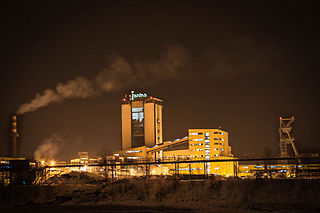Related Research Articles
Coal mining regions are significant resource extraction industries in many parts of the world. They provide a large amount of the fossil fuel energy in the world economy.
Chandgana Tal is a coal mine in the Mörön sum (district) of Khentii Province in eastern Mongolia.

Tavan Tolgoi is one of the world's largest untapped coking and thermal coal deposits, located in the Ömnögovi Province in southern Mongolia. It has a total estimated resource of 6.4 billion tonnes, one quarter of which is high quality coking coal. It is divided into six sections: Tsankhi, Ukhaa Khudag, Bor tolgoi, Borteeg, and Southwest and Eastern coalfields. The Tsankhi section is the largest part, and is divided into East and West Tsankhi - these have had the most focus recently.

Mining in the United Kingdom produces a wide variety of fossil fuels, metals, and industrial minerals due to its complex geology. In 2013, there were over 2,000 active mines, quarries, and offshore drilling sites on the continental land mass of the United Kingdom producing £34bn of minerals and employing 36,000 people.

The Janina coal mine is a large mine in the south of Poland in Libiąż, Lesser Poland Voivodeship, 350 km south-west of the capital, Warsaw. The mine has been erected by Compagnie Galicienne de Mines, a French mining company, in 1907. Between 1921 and 1939 the Janina mine was under management of its Polish chief executive, Zygmunt Szczotkowski. During World War II it was repurposed into one of the German Nazi concentration camps. After the war the Janina mine was nationalizated, as all enterprises with over 50 employees had been at that time.
The Dęby Szlacheckie coal mine is a large mine in the north of Poland in Dęby Szlacheckie, Greater Poland Voivodeship, 130 km north-west of the capital, Warsaw. Dęby Szlacheckie represents one of the largest coal reserves in Poland having estimated reserves of 92 million tonnes of coal. Annual coal production is around 3.3 million tonnes.
The Bilytska coal mine is a large coal mine located in the south-east of Ukraine in Donetsk Oblast. Bilytska represents one of the largest coal reserve in Ukraine having estimated reserves of 68.2 million tonnes of coal. The annual coal production is around 427,000 tonnes.
The Hlyboka coal mine is a large coal mine located in the south-east of Ukraine in Donetsk Oblast. Hlyboka represents one of the largest coal reserves in Ukraine having estimated reserves of 23.3 million tonnes. The annual coal production is around 647,000 tonnes.
The Kirov coal mine is a large coal mine located in the south-east of Ukraine in Donetsk Oblast. Kirov represents one of the largest coal reserves in Ukraine having estimated reserves of 23.6 million tonnes. The annual coal production is around 765,000 tonnes.

Mining is important to the national economy of Mongolia. Mongolia is one of the 29 resource-rich developing countries identified by the International Monetary Fund and exploration of copper and coal deposits are generating substantial additional revenue. Coal, copper, and gold are the principal reserves mined in Mongolia. Several gold mines are located about 110 kilometres (68 mi) north of Ulaanbaatar, such as Boroo Gold Mine and Gatsuurt Gold Mine. Khotgor Coal Mine is an open-pit coal mining site about 120 kilometres (75 mi) west of Ulaangom. Ömnögovi Province in the south of Mongolia is home to large scale mining projects such as the Tavan Tolgoi coal mine and the Oyu Tolgoi copper mine. Oyu Tolgoi mine is reported to have the potential to boost the national economy by a third but is subject to dispute over how the profits should be shared. The International Monetary Fund (IMF) has estimated that 71 percent of the income from the mine would go to Mongolia.
The Khushuut Coal Mine is a coal mine located in the Darvi sum in the Khovd aimag of western Mongolia.
The Ulaan Ovoo Coal Mine is a coal mine located in the Tüshig sum of Selenge aimag in northern Mongolia. It is located on the northern shore of the Zelter River a short distance west of the sum center.
The Övdög Khudag Coal Mine is a coal mine being developed in the Bayanjargalan sum of the Dundgovi in southern central Mongolia. The deposit has coal reserves amounting to projected 89 million tonnes of Lignite. Together with the "Ikh ulaan uul" deposit nearby it comprises the "Black Hills" development.
The Nuurst Khotgor Coal Mine is an open-pit coal mine, located about 80 km west of the Uvs Province capital Ulaangom and 25 km south of Üüreg Lake in Bökhmörön sum (district) of Uvs Province in western Mongolia.
The Aduunchuluun Coal Mine, also written as "Aduun Chuluun" coal mine is a coal mine located next to Choibalsan city in Dornod aimag of eastern Mongolia. The mine has coal reserves amounting to 423.8 million tonnes of coking coal, one of the largest coal reserves in Asia and the world. The mine has an annual production capacity of 0.6 million tonnes of coal. Owner is the Mongolyn Alt Corporation (MAK).
The Tevshiin Govi Coal Mine is a coal mine located in the Saintsagaan sum of Dundgovi aimag in southern central Mongolia.
The Khuut Coal Mine is a coal mine located in the Matad sum of Dornod aimag in eastern Mongolia.
The Saikhan-Ovoo Coal Mine is an underground coal mine located near Saikhan-Ovoo in the Saikhan sum of Bulgan aimag in northern Mongolia, to the north of Saikhan-Ovoo Mountain.
The Tsaidam Lake Coal Mine is a coal mine being developed in the Bayan sum of Töv aimag in central Mongolia.
The Erds Coal Mine is a coal mine located in eastern Mongolia. The mine has coal reserves amounting to 807 million tonnes of coking coal, one of the largest coal reserves in Asia and the world. The mine has an annual production capacity of 0.1 million tonnes of coal.
References
- ↑ "Tugrugnuur Coal Mine, Mongolia" (PDF). resources.newsresources.info. 2012. Archived from the original (PDF) on 2014-02-25. Retrieved 2013-07-09.